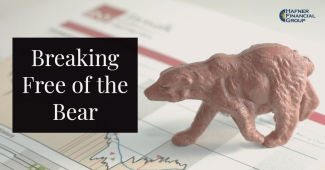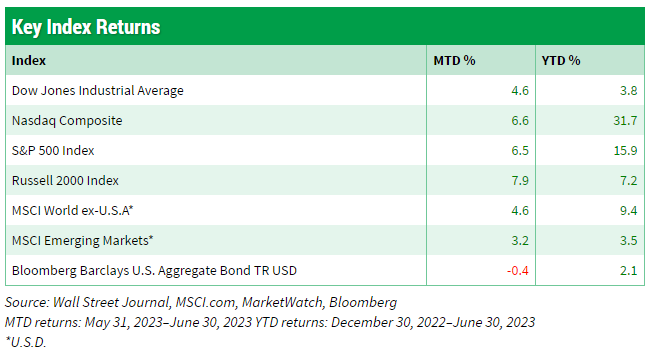
Breaking Free of the Bear
A bear market is defined as a 20% or greater drop in a major market index, usually the broad-based S&P 500 Index.
Unlike the better-known Dow, which comprises just 30 companies, the S&P 500, as its name implies, is made up of 500 firms and is considered a better benchmark of the overall stock market.
From its early 2022 peak to its most recent bottom last October, the S&P 500 shed 25% of its value (St. Louis Federal Reserve S&P 500 data). It met the standard definition of a bear market.
Just as a 20% peak-to-trough decline defines a bear market, a 20% rise from the most recent low marks the start of a new bull market, at least that is the technical definition.
Since the mid-October low, the S&P 500 has advanced 24.4%
Gaining the upper hand
What’s behind the advance? There has been no shortage of anxieties that might trip up investors, including a possible recession, still-high inflation, an ongoing war in Ukraine and this year’s banking crisis.
Despite the widespread anticipation of an economic downturn, it has yet to materialize, and employment opportunities continue to expand.
The Federal Reserve is considering raising interest rates further, but the magnitude of these increases has significantly decreased this year.
This year’s progress in the stock market can be primarily attributed to the slower pace of rate hikes and the growth of the economy. Furthermore, the fascination with artificial intelligence (AI) has significantly boosted the performance of technology stocks.
Living in a post-pandemic world
Forecasting trends is a challenging task for economists and analysts.
Despite the use of complex economic models, the post-pandemic world poses unique difficulties.
The shutdown and reopening of the economy, combined with an unprecedented $5 trillion in fiscal stimulus, have created economic distortions that are not fully accounted for in these models.
At the onset of the pandemic, the $2 trillion CARES Act and quick action by the Fed were crucial in preventing the economy from plummeting into an economic black hole.
But how do forecasters incorporate another $3 trillion in stimulus that was authorized between late December 2020 and March 2021?
How do the experts account for the shuttering and the reopening of the economy, pent-up demand, and the shift away from goods and toward services, travel and entertainment?
Talk to some retailers, and you would think we were on the cusp of a recession. But the airlines can’t keep up with demand and can’t seem to raise prices fast enough.
It’s a new challenge for the Fed, economists and investors, especially short-term traders who bet on daily, weekly or monthly market moves.
We don’t believe market timing is a realistic strategy. Just as no one rings a bell at a market peak, no one rings a bell when a bear market ends.
Market timers sometimes get lucky, but one must consistently catch the highs and lows to be successful.
Just as 2022’s bear market surprised most, many timers failed to anticipate the turnaround this year against the backdrop of a hefty dose of negative sentiment when the year began.
Successful long-term investors steer clear of chasing after trendy fads and the temptation to time the market. Instead, they adhere to a well-established and disciplined strategy that has consistently proven to be the most profitable path.
If you have any inquiries or wish to discuss any concerns, please don’t hesitate to contact me or any member of my team.


